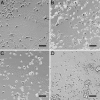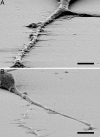A neuroinductive biomaterial based on dopamine
- PMID: 17075054
- PMCID: PMC1636515
- DOI: 10.1073/pnas.0606237103
A neuroinductive biomaterial based on dopamine
Abstract
Chemical messengers such as neurotransmitters play an important role in cell communication, differentiation, and survival. We have designed and synthesized a bioactive biomaterial that derived its biological activity from dopamine. The resultant biodegradable polymer, PCD, has pendent groups bearing dopamine functionalities. Image analysis demonstrated that nerve growth factor-primed rat pheochromocytoma cells (PC12) and explanted rat dorsal root ganglions attached well and displayed substantial neurite outgrowth on the polymer surface. Furthermore, PCD promoted more vigorous neurite outgrowth in PC12 cells than tissue culture polystyrene, laminin, and poly(d-lysine). The histogram of neurite length of PC12 cells showed distinctive patterns on PCD that were absent on the controls. A subset of PC12 cells displayed high filopodium density on PCD. The addition of dopamine in culture medium had little effect on the differentiation of PC12 cells on tissue culture polystyrene. Tyrosine, the precursor of dopamine, did not exhibit this ability to impart specific bioactivity to an analogous polymer. Thus, the dopamine functional group is likely the origin of the inductive effect. PCD did not cause nerve degeneration or fibrous encapsulation when implanted immediately adjacent to the rat sciatic nerves. This work is a step toward creating a diverse family of bioactive materials using small chemical messengers as monomers.
Conflict of interest statement
The authors declare no conflict of interest.
Figures








References
Publication types
MeSH terms
Substances
LinkOut - more resources
Full Text Sources
Other Literature Sources
Molecular Biology Databases

